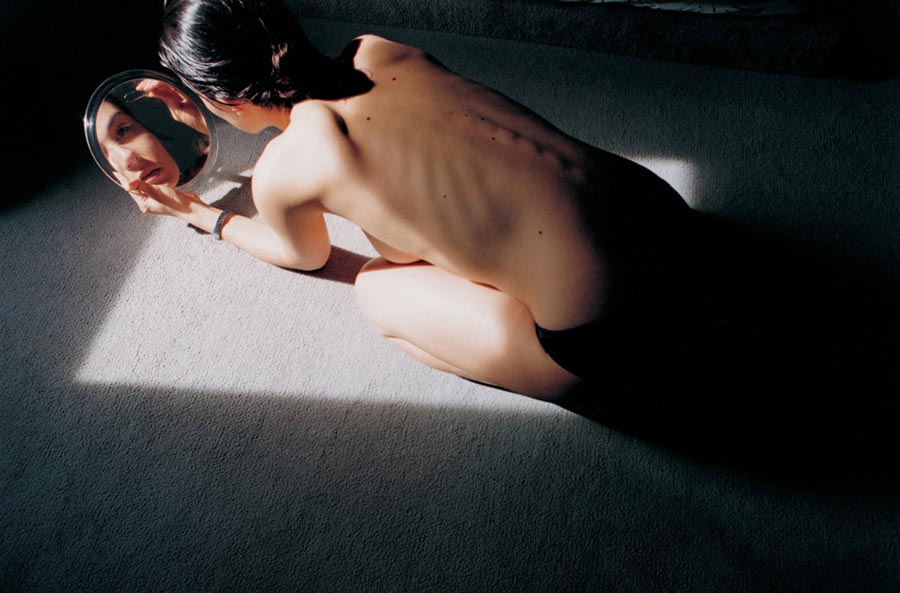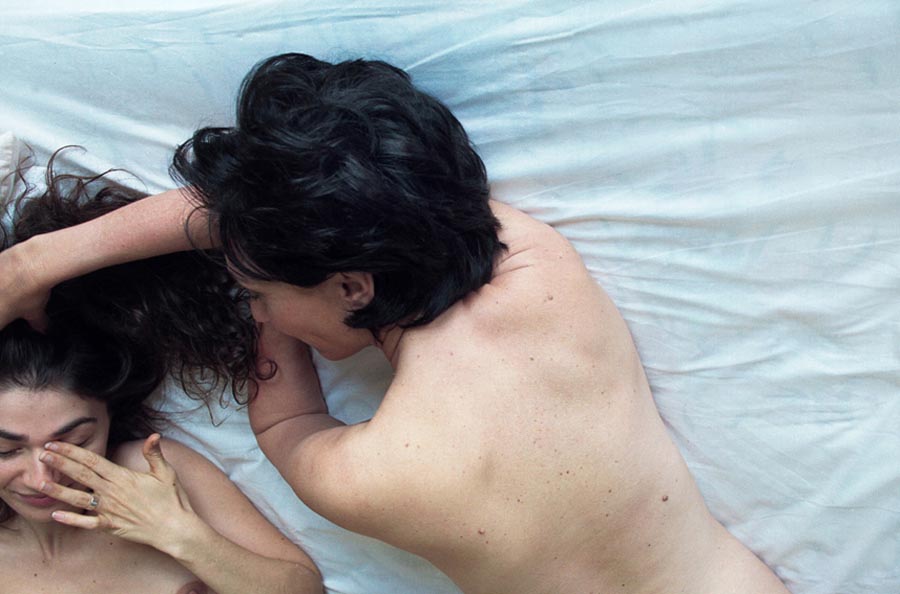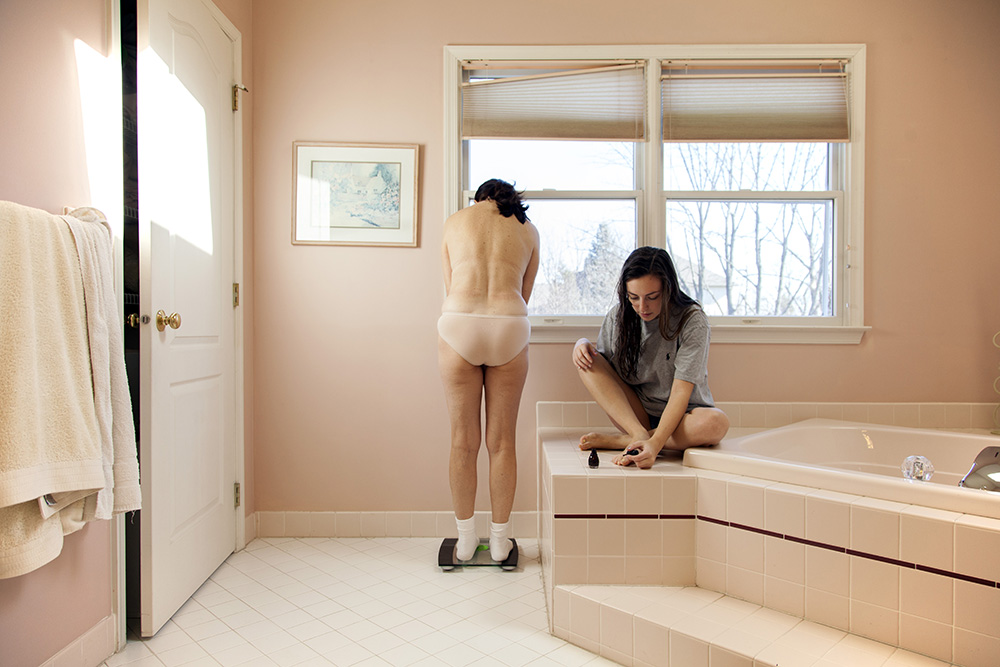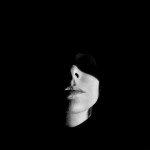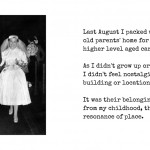Photographers on Photographers: Hannah Altman in Conversation with Elinor Carucci
Elinor Carucci embodies her work emotionally and compositionally. For decades, she has committed to photographing herself and her family to explore ideas of motherhood, daily life, relationships, and intimacy. Her images span generations, often using her own body in relation to others to contextualize her overlapping roles: mother, daughter, granddaughter, wife, artist, human. Documenting her most intimate moments from childbirth to aging, Carucci’s world unfolds in front of us in a way that balances being both organic and orchestrated. The elaborate stories that the photographs tell of her life echo modes of Jewish storytelling, of maternal oral knowledge, of pulling from deep into the mundane to lift universal truths to light. My own work tugs at similar threads. Having developed recents projects about motherhood and Jewish ritual, I was honored to speak with Elinor about sustaining long term projects, making Jewish feminist work, and allowing for images to develop new meanings over time.
Born 1971 in Jerusalem, Israel, to a Mizrahi Jewish family of North African, Middle Eastern and Italian descent, Elinor Carucci graduated in 1995 from Bezalel Academy of Arts and Design with a degree in photography, and moved to New York that same year. In a relatively short amount of time, her work has been included in an impressive amount of solo and group exhibitions worldwide, solo shows include Edwynn Houk gallery, Fifty One Fine Art Gallery, James Hyman and Gagosian Gallery, London among others and group show include The Museum of Modern Art New York and The Photographers’ Gallery, London.
Her photographs are included in the collections of The Museum of Modern Art New York, the Brooklyn Museum of Art, Houston Museum of Fine Art, among others and her work appeared in The New York Times Magazine, The New Yorker, Details, New York Magazine, W, Aperture, ARTnews and many more publications.
She was awarded the International Center of Photography Infinity Award for Young Photographer in 2001, The Guggenheim Fellowship in 2002 and NYFA in 2010. Carucci has published two monographs to date, Closer, Chronicle Books 2002 and Diary of a dancer, SteidlMack 2005and MOTHER, Prestel 2013. In fall of 2019 Monacelli Press published her fourth monograph, Midlife.
Carucci teaches at the graduate program of Photography and Related Media at School of Visual Arts and is represented by Edwynn Houk Gallery. Follow on instagram: @elinorcarucci
Hannah Altman: I have to say, I just am a true, true fan. There are few very visibly Jewish female artists whose work that I deeply admire, so I’m super excited to chat with you.
Elinor Carucci: Thank you, Hannah! There are some photographers who are very visibly Jewish and others that you’d be surprised by. My work stems from being Jewish and Israeli, and the family and the drama, and how intimate and mixed up it all is. And so I feel that in itself is Jewish, maybe not in the obvious kind of way, but it is.
HA: I feel like I’ve been hitting a wall describing what defines Jewish work, and I’m curious if this happens to you too. In America it feels like there are very narrow entry points of what people know about Jewishness, so by default all the work ends up being read in relation to Israel, or to Christianity, or the Holocaust. This feels very limiting to me, like I am expected to be making work about only these important but limited entry points.
EC: I have a lot of international students and sometimes I feel I have the same ignorance about others; I don’t necessarily know much about the specific region of where my students are from. So I am forgiving, because people can’t possibly deeply understand it all. I just do a lot of explaining about myself, and try to fill my gaps for others. I didn’t grow up in America, and many experiences my students face I haven’t experienced first hand. I have to do my homework. And that’s just part of it. Many Americans don’t really see the difference between Israelis and American Jews. They don’t know anything about Ashkenazi versus Sephardic versus Ethiopian Jews, Russian Jews, it’s all one thing for them.
I’m Mizrahi, my family is from the Mediterranean and the Middle East, and I remember I had an opening where someone brought us smoked salmon and things I’ve never eaten and have never heard of, because it was Ashkenazi food. But we were very kind about it. It was very kind and I was grateful for a gift, but we can’t expect people to know 3,000 years of history and different Jewish cultures.
HA: You bring up a good point that you can’t expect everyone to know all of the things. So in that way, if Americans really know about Jewishness through these narrow access points, your work carves a new, wider pathway.
EC: Right, the work is universal, but it comes from growing up in the family I grew up in.
HA: Because your work is long-term projects, you’ve explored motherhood as both a daughter and more recently as a mother. Can you just tell me more about how you maintain these long-term projects with family members as they age, especially as they are growing up in different countries? I imagine that there’s periods where the participants are more or less willing, depending on circumstance, age, or location.
EC: It’s interesting. Had I stayed in Israel who raised my kids there, who knows what the work would have looked like. And the fact that I immigrated to America affected my work. I believe that I would probably have more coverage of my mom and more work with her. There are a lot of things that happened in my life that affected the way that I photographed my mom. She’s aged, she’s not as open to be photographed. I’m 49. When I started photographing my mom, I was 15, she was 35. Part of the fact that she was so open to my work was that she was young and beautiful and that has changed over the years. Some of this I just have to accept. You have to walk the line of being sensitive and respectful and accepting, but then maybe, you know, beg (laughs). It’s complicated.
HA: And do you think documenting her for so many decades helps or hurts that sense of willingness as she ages?
EC: I think it definitely brought us closer to one another over the years, but I think what hurts is the exposure the work is getting. When I started to take pictures of her, I was 15. I was 24 when the work was first shown as a school exhibition, but now the work is shown everywhere. So I think for my mom, it’s both the fact that she aged, but it’s also the fact that she knows it will be seen. She has to approve every image that I’m sharing knowing that the exposure is bigger.
HA: I’ve had a similar experience working on a self portrait project with my mom for about seven years. In some of the earlier images she didn’t quite know what I was doing and how it would be viewed. There was much more of a “make whatever images you want” supportive attitude from her end. Now I think she not only wants a clearer direction during the shoot, which has resulted in better images, but she also wants to know where it’s showing, if it’s being shared online. It’s interesting terrain to navigate with somebody who’s a little bit older, but I also wonder how that affects your children. They’re entirely immersed in visual culture from birth, so I imagine it’s a bit of a different story.
EC: I think with kids, with their generation, they have control over their platform, which is something we didn’t have until 15 years ago. They have their Instagram where they choose how to photograph and share themselves. Sometimes it’s so different from the way I portray them and their friends. There is more of an awareness as they also became teenagers. I’m not going to show the work that I’ve been making of them since they’ve been 13 for many years. I always tell them, I’m not going to show anything now. By the time I’m showing the work, you will be over 20. Then you might feel differently, feel like less of a teenager. You just have more of a critical distance when it’s an image of yourself when you’re 13 than when you’re 18, you have that distance enough to be like, yes, this was so awkward of a time, but at least I don’t feel as personally tied to the image as I might have.
HA: Do you frame the work that you build with your children as a collaborative process? Or do you view it more as your work in your sort of documenting them?
EC: I think it’s both. Every photograph that involves another person has some kind of a collaboration, but it is my work. This is my point of view. If you gave my children a camera to document their lives from zero to 18, it would probably look very different. And some of the images they see of themselves, they say that they didn’t really feel like that. So for good and for bad, my work requires collaboration.
HA: This relates to the way that your images are both candid and staged simultaneously.
EC: The way that I work is very much in the spectrum between completely staged with a lot of room for things to happen. And the fact that they’re staged doesn’t mean that they’re less honest. I wish there was a different word for it; “stage” has this negative connotation of performance.
There’s a little bit of performance within family dynamics, but often I feel like the camera is more of a vehicle. The camera is a tool towards honesty in that way.
HA: Do you find that these truths sort of emerge as you’re taking photos? Or is that something that kind of comes later? I’m wondering if honesty is ever cemented or if it’s always fluid.
EC: Many times what you wanted to photograph, you’ll end up photographing something else. Sometimes it will really reveal some kind of honest moment. And then among those images, I’ll pick one image and then two years later I’ll be like “why did I pick this, this different one is much more truthful to what we’re going through.” It’s a very dynamic decision-making process.
HA: How does your perspective of being a Jewish woman impact the way you present those ideas?
EC: There is a lot of emphasis on motherhood in Judaism. And I often see Judaism as more of a cultural thing than a religious thing. The cultural aspect is very much a part of my work: the need to talk about everything and go deep. In Hebrew we say to dig, to dig into everything and expand, especially among women.
HA: How do you navigate the separation of projects? They all live under the same umbrella of life experience.
EC: They’re divided by the books, sometimes it’s just the end of an era and I’ll finish it. Because Closer is still all negatives, I look less into it. But many times when I get requests for images, I will go through them to find the negative and notice images I didn’t pick up, but the way we look at our own art always changes.
HA: Do you think that openness helps fill the gaps between periods of photographing your mother and your parents because they’re not in the same country? The ability to sort of sift through images years after must keep an active practice, even if you’re not geographically in the same location.
EC: I feel the work suffers from the distance. I can’t sugarcoat. I would definitely have photographed them much more. My father couldn’t leave Israel for many years. The work definitely suffered from it. Other things happen because I’m here in America. The distance from my family, there’s a price: emotionally, mentally, and photographically.
HA: You’ve been in America since the nineties, a very active time for conversations on photography and motherhood. I feel like your work fit in that discourse, but you were distanced from the actual subject matter. I imagine that was difficult.
EC: My mom really wanted me to be here where I’ll have more opportunities. Israel is very small and in a funny way, the kind of work that I do is not so trendy in Israel. Much of the highlighted work there doesn’t really represent a lot of the culture or people, because I have a huge following from Israel of people that love the work; I think the work is very Israeli. People relate to the emotion and the dramas of the family and the every day and motherhood, but somehow it’s not represented much there. My mom and I began to feel how that would limit me. She really wanted me to leave Israel and to be in New York.
HA: Can you tell me more about your transition when you first got to New York?
EC: It was really difficult. There is a saying in Hebrew, to be a good Jerusalem girl. I was very close to my family. I lived in my parent’s basement until I was 24, so the move was so scary and intimidating. Being here, going into the galleries with my OK English, there were many things I didn’t know, it was really, really difficult. Still today I have a love-hate relationship with the city. If my career is going well, I love the city. And if my career is not doing well and it’s one of those bad times and believe me, I have them, I hate the city and want to leave.
HA: How did you start to make connections in New York and beyond in the gallery world?
EC: The fact that I didn’t know anything and I was just so proactive was good, because I just walked into galleries. This is before the internet. I opened yellow pages looking for galleries. I walked into the galleries with slides and little postcards of my images trying to talk to the receptionist. I remember when I came to pick up my slides from Yancey Richardson, she came to the reception and she said, let me keep those slides for group shows. There was a lot of good about the fact that there wasn’t the internet and emails. There were not, I feel, as bombarded by artists as they are today. A lot of it was just like trying to meet people, write to people, calling up people; there were a lot of failures and a lot of people who just ignored me, but that’s what I did.
HA: What replaces that sort of physical connection in digital prioritized times? Walking into a gallery with images feels inaccessible now, though I’ve done it. It feels like much of the artwork is an unsolicited bother instead of a potential relationship.
EC: I think up until 10 years ago, magazines still did portfolio work where you would drop off your portfolio. And then many times when you come to pick it up, the photo editor would come and chat with you for a few minutes. Those things don’t happen. You can walk into a gallery, but you also can email. You can follow people on Instagram. You can DM photo editors. Some things are not so much an option, but others are. Was it harder than, or harder now? I don’t know. It’s just different, but it was always a very competitive field.
HA: For the brave people that do answer, how do you maintain those relationships so that they know what you’re working on? Is there a different approach that comes with building relationships for editorial assignments?
EC: I just try to keep it with my social media. That’s the main thing, keeping it active and keeping people informed. I can’t promote myself and then chase the curators, the museums, the photo editors. At some point I decided to give in to my identity as an artist and put most of the effort into getting shows and my books published, and then promote that when it happens. The magazine jobs will follow. I take editorial jobs they’re right for me. Meanwhile I’m working as a teacher and selling my work, and because of the books and exhibitions, usually the magazine people will be aware of my bodies with work and what I’m doing.
HA: How do you navigate those commissioned assignments so that they still feel personal?
EC: It’s been years of failing in some areas for me, like fashion or advertisement isn’t my strongest. So people don’t even come to me for those assignments anymore, so it’s not like I have to be so selective. They’re like, oh no, this a Jewish feminist in know late forties, this assignment is not for her. It’s 23 years now of shooting for magazines and now the assignments I get are right, because people will not send me to photograph things I don’t have a connection to. Some photo editors I’ve known for 15 years, and they know me and what’s right for me. And I’m not going to aim for the same depth and intimacy as I do with my mom and myself and my child, but I’m bringing me, Elinor, just the photographer that I am, the woman that I am, and the intimacy and the respect that I want to show with my work.
HA: Do you have any advice that you wish you had been given when you were my age, 26?
EC: Follow your heart. I think sometimes the path you thought was the right one, the successful one, will not necessarily be the one that is right for you. So you have to follow the path in your heart, and distinguish between what you’re just nervous about and what’s really not right for you, making you miserable and killing your love for photography. You have to be proactive within your own way. It can be a quiet way, or a loud or social way, or an email way, just lean into what makes you and your relationships better.
HA: I think that’s good advice.
Hannah Altman is a Jewish-American artist from New Jersey. She holds an MFA from Virginia Commonwealth University. Through photographic based media, her work interprets relationships between gestures, the body, lineage, and interior space.
She has recently exhibited with the Virginia Museum of Contemporary Art, Blue Sky Gallery, the Pittsburgh Cultural Trust, and Photoville Festival. Her work has been featured in publications such as Vanity Fair, Carnegie Museum of Art Storyboard, Huffington Post, New York Times, Fotoroom, Cosmopolitan, i-D, and British Journal of Photography. She was included in the 2020 Critical Mass and Lenscratch Student Prize Finalists and in the Silver Eye Center For Photography’s 2021 Silver List.
She has delivered lectures on her work and research across the country, including Yale University and the Society for Photographic Education National Conference. Her first monograph Kavana, published by Kris Graves Projects, is in the permanent collections of the MoMa Library and the Metropolitan Museum of Art Thomas J Watson Library. Follow on instagram: @hannah.altman
Posts on Lenscratch may not be reproduced without the permission of the Lenscratch staff and the photographer.
Recommended
-
Earth Month Photographers on Photographers: Tyler Green in Conversation with Megan JacobsApril 15th, 2024
-
Shari Yantra Marcacci: All My Heart is in EclipseApril 14th, 2024
-
Artists of Türkiye: Cansu YildiranMarch 29th, 2024
-
Broad Strokes III: Joan Haseltine: The Girl Who Escaped and Other StoriesMarch 9th, 2024
-
Brandon Tauszik: Fifteen VaultsMarch 3rd, 2024








